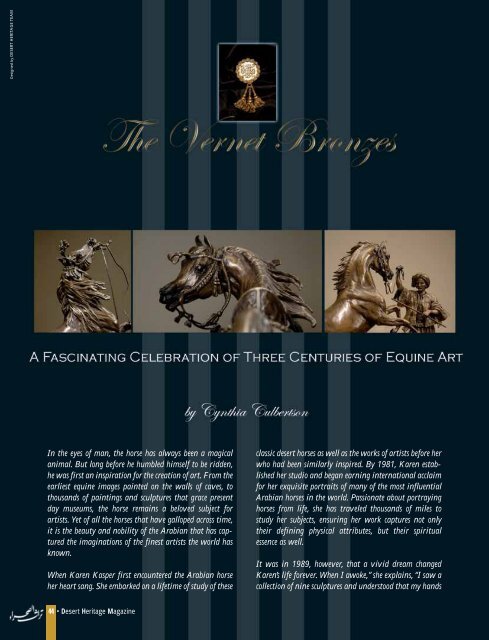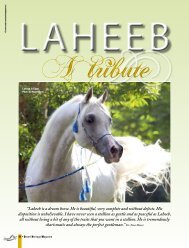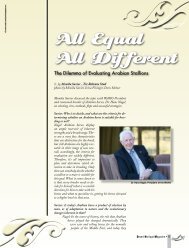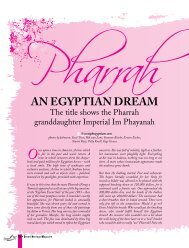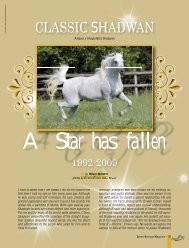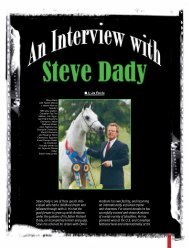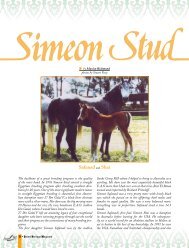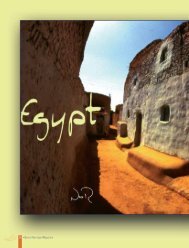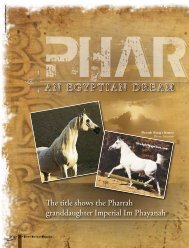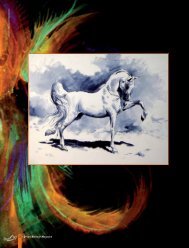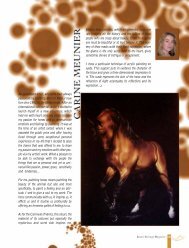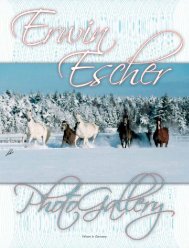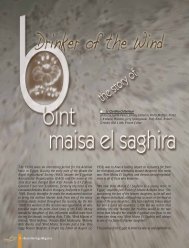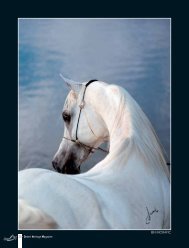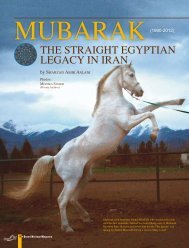Karen Kasper - Desertheritagemagazine.com desert heritage ...
Karen Kasper - Desertheritagemagazine.com desert heritage ...
Karen Kasper - Desertheritagemagazine.com desert heritage ...
Create successful ePaper yourself
Turn your PDF publications into a flip-book with our unique Google optimized e-Paper software.
Designed by DESERT HERITAGE TEAM<br />
In the eyes of man, the horse has always been a magical<br />
animal. But long before he humbled himself to be ridden,<br />
he was first an inspiration for the creation of art. From the<br />
earliest equine images painted on the walls of caves, to<br />
thousands of paintings and sculptures that grace present<br />
day museums, the horse remains a beloved subject for<br />
artists. Yet of all the horses that have galloped across time,<br />
it is the beauty and nobility of the Arabian that has captured<br />
the imaginations of the finest artists the world has<br />
known.<br />
When <strong>Karen</strong> <strong>Kasper</strong> first encountered the Arabian horse<br />
her heart sang. She embarked on a lifetime of study of these<br />
44<br />
Desert Heritage Magazine<br />
classic <strong>desert</strong> horses as well as the works of artists before her<br />
who had been similarly inspired. By 1981, <strong>Karen</strong> established<br />
her studio and began earning international acclaim<br />
for her exquisite portraits of many of the most influential<br />
Arabian horses in the world. Passionate about portraying<br />
horses from life, she has traveled thousands of miles to<br />
study her subjects, ensuring her work captures not only<br />
their defining physical attributes, but their spiritual<br />
essence as well.<br />
It was in 1989, however, that a vivid dream changed<br />
<strong>Karen</strong>’s life forever. When I awoke,” she explains, “I saw a<br />
collection of nine sculptures and understood that my hands
Photo by Lenita Perroy<br />
Contemporary artist <strong>Karen</strong> <strong>Kasper</strong> has created nine extraordinary sculptures<br />
celebrating three centuries of equine art.<br />
were to create them.” Over the years that<br />
followed, this dream evolved into reality, to<br />
be<strong>com</strong>e one of the most fascinating art<br />
endeavors ever inspired by the Arabian<br />
horse.<br />
The Concept<br />
The 19 th Century French Artist, Carle<br />
Vernet<br />
The Arabian horse is a favorite subject in<br />
the lavish orientalist art of the 18th and<br />
19th centuries and these works have<br />
enthralled generations of Arabian horse<br />
enthusiasts. Many contemporary breeders<br />
readily admit visualizing these classic<br />
images when striving to breed their ideal<br />
Arabian. Among the most <strong>com</strong>pelling of<br />
these works are Carle Vernet’s exquisite<br />
renderings of the horses of the Mamelukes,<br />
inspired by the beautiful Arabians brought<br />
back to Europe from Egypt during the<br />
Napoleonic era.<br />
<strong>Karen</strong> <strong>Kasper</strong> has always felt a deep bond<br />
with Carle Vernet. “He was a master at<br />
drawing details, expressions and body lan-<br />
The sculpture collection entitled “The Vernet Bronzes” portrays nine of<br />
the classic Arabian horse drawings of the 19th century French artist,<br />
Carle Vernet<br />
All of the sculptures were created by meticulously following the landmark<br />
anatomy studies of the 18th century British artist, George Stubbs<br />
Desert Heritage Magazine 45
guage,” she relates, “and taught a number of young students<br />
who went on to be<strong>com</strong>e famous artists themselves,<br />
including Gericault.” When <strong>Karen</strong> saw a portrait of the<br />
young Carle at age 14, she immediately sensed a deep personal<br />
connection. “I intimately understood his expression:<br />
a sense of awareness and devotion to one’s creative gift.”<br />
Then something truly magical happened. As <strong>Karen</strong> stud-<br />
46<br />
Desert Heritage Magazine<br />
I. The Invitation II. The Resistance III. The Sword of Truth<br />
IV. The Conscience V. The Charge VI. The Dance<br />
VII. The Visionary VIII. Genuine Wealth IX. The Tree of Life<br />
After studying Carle Vernet’s many depictions of the Arabian horse, <strong>Karen</strong> <strong>Kasper</strong> chose these<br />
nine images to be sculpted. Because his art inspired the collection, she titled them “The Vernet<br />
Bronzes” in his honor. As she began her sculptures, she gave each of the nine its own special<br />
name based on her interpretation of the image.<br />
ied the drawings of Carle Vernet, nine of his many images<br />
sprang to life in her mind. She visualized them beyond<br />
their two-dimensional state, be<strong>com</strong>ing life-like fully<br />
dimensional sculptures. “Although Vernet was never<br />
known to have sculpted,” <strong>Karen</strong> explains, “it was his art<br />
that inspired me to create ‘The Vernet Bronzes’, which I<br />
titled in his honor. In fact, they would not exist without<br />
him.”
<strong>Karen</strong> <strong>Kasper</strong> began her work by first<br />
studying the exquisite details and<br />
expressions of Carle Vernet’s Arabian<br />
horses<br />
The process of creating “The Vernet Bronzes” continued as<br />
<strong>Karen</strong> developed each horse, layer by layer, following the<br />
sequential anatomy charts drawn by George Stubbs more<br />
than 200 years ago.<br />
The 18 th Century British Artist, George Stubbs<br />
The story of “The Vernet Bronzes” had begun, and <strong>Karen</strong>’s<br />
studies soon convinced her that Carle Vernet had gained<br />
much of his knowledge of equine anatomy from another<br />
artist who preceded him – George Stubbs. “Stubbs revolutionized<br />
equine art,” states <strong>Karen</strong>, “by <strong>com</strong>bining his creative<br />
abilities with extraordinary scientific talent. He<br />
truly believed that nature was the greatest teacher, and<br />
<strong>Karen</strong> then similarly posed a sculpted skeleton, based on<br />
her exacting study of the skeleton of Bairacter, a famous<br />
Arabian stallion that lived during Vernet’s lifetime.<br />
Each sculpture was further enhanced with realistic details<br />
observed throughout <strong>Karen</strong>’s lifetime of study of the<br />
Arabian breed. The finished sculptures were then molded<br />
and cast into bronze, the most enduring art medium known<br />
to mankind.<br />
spent more than a decade dissecting the horse, and meticulously<br />
recording its anatomy. He published ‘The Anatomy<br />
of the Horse’ to educate other artists and horsemen in an<br />
understanding of ‘what lies beneath the skin.’<br />
Stubbs demonstrated his genius by developing three key<br />
views of the horse, with six different layers of anatomy<br />
dissection for each view. Along with their respective mirror<br />
images, Stubbs’ drawings provide a <strong>com</strong>plete reference<br />
Desert Heritage Magazine 47
to the form of the horse, at each anatomy level. “I began my<br />
first sculpture from Stubbs’ skeleton chart,” <strong>Karen</strong> relates,<br />
“and developed it following the sequence of his anatomy<br />
levels. This was an incredibly profound experience, and<br />
proved that this was the method I was to follow in creating<br />
‘The Vernet Bronzes.’”<br />
The Historic Arabian Stallion Bairactar<br />
Once <strong>Karen</strong> realized that she would create ‘The Vernet<br />
Bronzes’ from the skeleton up, she realized that Stubbs’<br />
charts were based on an English horse, and not on an<br />
“The Invitation” was unveiled in Paris, at the 2007 Championnat du Monde du Cheval Arabe<br />
Arabian. She then sought an authentic Arabian skeleton,<br />
with the breed’s characteristic five lumbar vertebrae, upon<br />
which to base her sculptures.<br />
“Deep in the heart of Germany, I found the preserved<br />
skeleton of Bairactar in the museum of the Marbach State<br />
Stud,” <strong>Karen</strong> explains. “Bairactar was born in the <strong>desert</strong><br />
in 1814, and imported to Germany in 1817 where he<br />
founded a sire line that continues to the present day. At my<br />
first sight of this skeleton, I knew immediately that a new<br />
dimension of realism was possible. My sculptures could<br />
now be accurately founded on the proportions of an<br />
48<br />
Desert Heritage Magazine<br />
Arabian stallion that actually lived during Carle Vernet’s<br />
lifetime.”<br />
The Creation<br />
The 20 th Century American Artist, <strong>Karen</strong> <strong>Kasper</strong><br />
Upon finding the skeleton of Bairactar, <strong>Karen</strong>’s vision of<br />
the process she would use to create “The Vernet Bronzes”<br />
was <strong>com</strong>plete. She was graciously allowed to make a study<br />
of each bone of the skeleton and returned to her studio to
“The Dance” was unveiled in Lexington, Kentucky at the 2007 Egyptian Event<br />
sculpt an exact scale model. She then replicated this skeleton<br />
nine times, and posed each in the position of the<br />
Arabian horse of the nine Vernet images she had chosen.<br />
As she continued the process of <strong>com</strong>pleting the sculptures<br />
layer by layer, she realized that her personal passion for life<br />
studies of the horse would be her own artistic contribution<br />
to “The Vernet Bronzes.” “I understood that I was to<br />
incorporate the truth, as I saw it, of the beauty of the<br />
equine form and expression from my own studies of living<br />
horses,” she explains. To further my understanding and<br />
interpretation of Stubbs’ drawings I participated in horse<br />
dissections with a veterinarian to learn the exact form and<br />
dimensions of flesh over bone.” <strong>Karen</strong> also mapped the<br />
arteries and veins of a living Arabian stallion, as his heart<br />
beat with excitement, to further add to the realism of her<br />
<strong>com</strong>pleted sculptures.<br />
“Though I began following Carle Vernet’s nine lithographs<br />
as accurately as possible,” says <strong>Karen</strong>, “my own life<br />
observations sometimes revealed additional details, which<br />
I then incorporated from living horses.”<br />
Desert Heritage Magazine 49
The Collection<br />
This original and unprecedented sculpture collection is a<br />
result of blending the talents of three centuries of equine<br />
art, and <strong>Karen</strong> <strong>Kasper</strong> is adamant in her belief that<br />
artists, through their work, are inexplicably linked across<br />
time. “Those of us who have learned from the artists of the<br />
past share a responsibility to pass our knowledge forward<br />
to the artists of the future,” she relates. “To this end, I have<br />
kept a diary of my work on these sculptures, and chronicled<br />
their progression in thousands of images.”<br />
“The Resistance” was presented in Lanaken, Belgium at the 2007 Egyptian Event Europe<br />
Throughout the many years since <strong>Karen</strong> first envisioned<br />
“The Vernet Bronzes” she has followed a personal quest to<br />
seek the knowledge, skills, and techniques necessary to<br />
transform her vision into a reality. “Looking back,” she<br />
explains, “nearly everything I have experienced has been<br />
necessary to <strong>com</strong>plete this art. I have traveled extensively,<br />
visiting libraries, museums and private art collections<br />
throughout the United States, Europe and the Middle<br />
East. From studying the ornate trappings of the<br />
Mameluke tack and saddlery, to the period of history that<br />
was portrayed by the Orientalist art movement, to standing<br />
in the actual locations where this history took place, all<br />
50<br />
Desert Heritage Magazine<br />
of these experiences have truly enriched ‘The Vernet<br />
Bronzes.’”<br />
Although each sculpture began from the single view of<br />
Carle Vernet’s lithographs, <strong>Karen</strong> discovered a number of<br />
details previously unnoticed in his images as she <strong>com</strong>pleted<br />
her process. “My sculpting them in three dimensions has<br />
created an infinite number of new views of these subjects,<br />
never before seen in the world.” The Vernet Bronzes are<br />
now being presented, one by one, in a series of international<br />
unveilings. To date, four of the nine bronzes have<br />
been introduced to the public at Arabian horse celebrations
“The Tree of Life” was unveiled in Egypt at a celebration hosted at Al Khaled Farm by Sheikh<br />
Khaled Ahmed Bagedo, a patron of “The Vernet Bronzes.”<br />
in four different countries – Egypt, the United States,<br />
Belgium and France. As each sculpture is revealed, the<br />
response of the audience is a profound sense of wonderment<br />
and awe, as these new views of a familiar image are experienced<br />
for the first time.<br />
Like many artists, <strong>Karen</strong> expresses her heartfelt appreciation<br />
to the patrons of her art. “I am especially grateful to<br />
Count Federico Zichy-Thyssen,” she states, “who was the<br />
first patron of ‘The Vernet Bronzes,’ as well as to Sheikh<br />
Khaled Ahmed Bagedo and my other patrons, who are<br />
private collectors. They have patiently supported this lifework<br />
and shared my joy of watching ‘The Vernet Bronzes’<br />
<strong>com</strong>e to life. I also have to thank my husband, Ray, whose<br />
steadfast support and assistance throughout my career has<br />
been invaluable.”<br />
To <strong>Karen</strong>, the story of “The Vernet Bronzes” continues to<br />
unfold, from artists of the past, to her own contribution, and<br />
onward to artists of the future. “It all began with my love of the<br />
Arabian horse,” she reminisces, “and has followed a wondrous<br />
path, transcending cultures and countries, history and art…” ❏<br />
Desert Heritage Magazine 51


